Last weekend I played two games in the 4ncl. It went well.
John Shaw (2426) – John Richardson (2330)
4ncl 14.02.2015
Assess the position and choose a move for White.
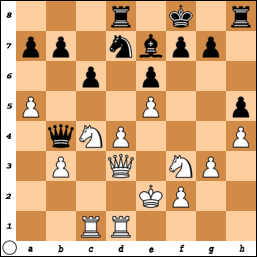
22.a6!?
Lining up a queen sac. It’s great fun and, with hindsight, I am glad I played it, but my choice was based on a total misassessment of the current position.
My thoughts during the game were: “If I allow Black to play …a7-a6 then I have no pawn breaks and no play. I think Black might be better then.”
Hilariously wrong. In fact, I can choose several other moves, allow …a7-a6, and still be considerably better. My plans should include putting my knight on g5, and if the bishop takes it, then later my other knight can land on d6. I have more space, greater activity and attacking prospects against the enemy king. Instead I was staring worriedly at the hole on d5.
22.Ng5!± is strong.
Another simple and good option is 22.Qe3!? with the idea 22…a6 23.Ng5.
Or I could ask the excellent question: What is my worst-placed piece? Well, my king is a little out and about, so I could head for the security of g2: 22.Kf1!? Relying on the tactic: 22…Nc5 23.Qe2! Nxb3? (23…Na6) 24.Rb1+–
22…Nc5
The principled test. Instead 22…bxa6 23.Ng5 leaves Black struggling on both sides of the board.
23.dxc5!
I was committed, as my queen and a6-pawn were both attacked.
23…Rxd3 24.Rxd3 bxa6
Maybe 24…g6 is a tougher test, but after 25.axb7 Qxb7 26.Nd6 I prefer White.
25.Nd6
White has more than enough compensation. The knight is a star. Black must either tolerate it, or create a protected passed pawn on the sixth. In material terms I have just a rook and knight for a queen and pawn, but all my pieces coordinate perfectly; meanwhile the h8-rook is a passenger.
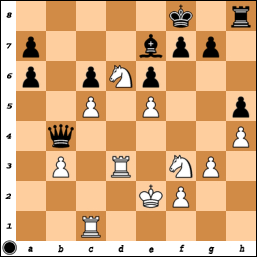
25…Bxd6?
Understandable but I think Black had to suffer the knight’s presence. Perhaps 25…g5!? might create some counterplay.
26.Rc4
This seemed simplest, though also fine was 26.cxd6 Qe4+ 27.Re3 Qd5 28.Rc4 and Rd3 next.
26…Qb7 27.cxd6 Qb5
Now it’s all over, but there was no way out anyway. For example: 27…f6 28.Nd4 Kf7 29.Nxc6 Qd7 30.Nd4 Rc8 31.Rdc3 (31.f4!? is the sadist’s move) 31…Rxc4 32.Rxc4+–
28.d7 Ke7 29.Nd4 Qxe5+ 30.Kf1 Kf6
30…Kxd7 31.Nxc6+ would leave me a knight up.
31.Nxc6 Qa1+ 32.Kg2 Qb1 33.Rf3+ Kg6 34.Ne5+ Kh7 35.Rc8

Black resigns as after 35…Qd1 36.Rxh8+ Kxh8 every plausible move wins: 37.d8Q+, 37.Rd3, 37.Nd3, 37.Nxf7+…
So that was Saturday. Sunday was even more fun.
Richard Palliser (2445) – John Shaw (2426)
4ncl 15.02.2015
I had played a Sicilian Scheveningen for the first time in my life.
It’s not a puzzle position as Black has lots of good moves. So maybe the question is: find the flashiest possible win.
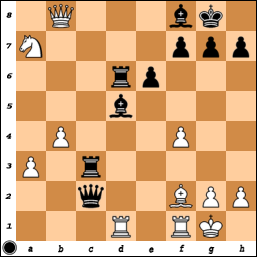
23…Rd3!?
When I saw the potential finish, I could not play any other move. Also, I couldn’t bear my lovely bishop on d5 being taken by a mere rook.
The simple 23…Qe4! was winning more easily. After 24.Rxd5 Rxd5–+ I was not sure during the game how clear this was, with White’s queenside pawns feeling menacing, but with an engine nudging me, it becomes obvious that Black wins quickly. For example: 25.b5 Qe2 Exchanging White’s rook dooms the king. 26.h3 Rd1 27.Rxd1 Qxd1+ 28.Kh2 Rc1–+
23…h6!?–+ is also good enough, avoiding any back-rank embarrassment. But why is that relevant? Let’s see: 24.b5 Bxg2! 25.Rxd6 Bxf1 26.Rd8 Bh3 27.Rxf8+ Kh7–+ Ah ha.
Other good options included 23…Rb3!? and 23…Rd7!?.
But 23…Bxg2? 24.Rxd6= Bxf1? is best avoided: 25.Nc6! Rxc6 26.Rd8 h6 27.Rxf8+ Kh7 28.f5 and White has an edge.
24.Rc1
The natural move but allowing my idea.
24.Rxd3 was essential, but after 24…Qxd3 Black should win eventually.
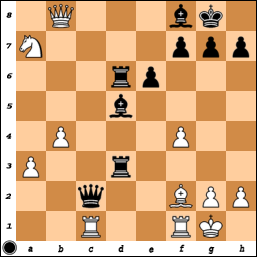
24…Rg3!!
The lines are short and clear, but I don’t think I have ever played a more enjoyable move. I needed it, as every other move loses.
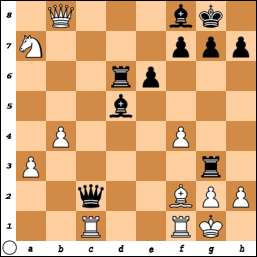
25.hxg3
25.Rxc2 Rxg2+ 26.Kh1 Rg3# or 25.Bxg3 Qxg2#.
25…Qe4
Taking on f8 only allows a few spite checks, so Richard sportingly resigned and said “Nice move.”
Saw the last combination on Spraggett’s blog. Great one!
Beautiful! Did the spectators shower the board with gold coins?
@dfan
Sadly no. Disappointing, especially as I did land my gold-coin move on the historically correct g3-square. But I have read there are suggestions Marshall made up his story, so maybe I should also: “The excitable English fans threw their credit card details on the board.”
Wow! Brilliant, daring, and elegant in both games against formidable opponents. Very instructive—not in the sense that I could duplicate such moves, but to keep looking for the easy to overlook. Re your comment on move 25 in game one—it sums up a frequent dilemma for black in the Stonewall (granted with the strong knight on e5) if white can slip in f4—you sort of have to kill the knight, BUT if you do the death pawn then materializes. I felt some sympathy for your opponent at this moment!
I was wondering if the black queen could be trapped on example 1 but did consider Ng5
Very sweet finish in the 2nd game 🙂 Most ‘un-John Shaw-like’ tactical play though! Bad influences in the office?
@Andy Burnett
Thanks Andy (I think). I did decide to try to play more actively than my usual style.